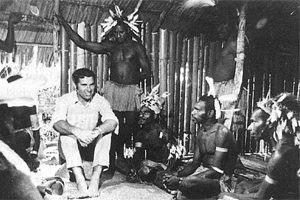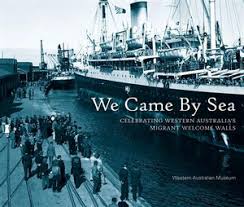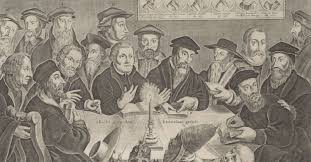In the late 1800’s, there was growing interest among Catholic women to become more involved in overseas missionary work. This was linked to the rapid colonisation occurring among European countries. In many places, woman and children in particular had no status, and thus no opportunities to develop the quality of life that true Christianity offers to everyone. And male missionaries were not allowed to offer it to them.
In 1889, German priest and scientist, Arnold Janssen, together with German women Helena Stollenwerk and Hendrina Stenmanns, founded the Holy Spirit Missionary Sisters (in Dutch: “Dienaressen van de Heilige Geest” in German: “Dienerinnen des Heiligen Geistes von der ewigen Anbetung”). Already in 1875, he had begun the Divine Word Missionary Priests and Brothers, in the village of Steyl, in the Dutch province of Limburg. He was unable to begin in Germany, because of Chancellor Bismarck’s persecution of the Catholic Church at the time. Their current head office is in Uden in the Netherlands.
Both Helena and Hendrina worked as house maids in the men’s establishment until Arnold was ready to establish a women’s missionary group. These, and others like them, were prepared to be sent anywhere in the world to spread Jesus’ Good News – love for everyone, born as equals in their humanity, dignity and destiny. The Sisters were well trained in the many skills they would need to offer a better quality of life at all levels. In 1895, they began their first overseas mission in Argentina; 1897, Togo; and in 1899, four sisters travelled to German New Guinea for their first mission in that colony.
German New Guinea
| German New Guinea consisted of the north-eastern part of New Guinea and several nearby island groups. Not wanted to be left out by the other colonising European nations this became the first part of the German colonial empire. The mainland part of the territory, called Kaiser-Wilhelmsland, became a German protectorate in 1884. Other island groups were added subsequently.The Bismarck Archipelago (New Britain, New Ireland, and several smaller islands), and the North Solomon Islands were declared a German protectorate in 1885; in the same year, the Marshall Islands were bought from Spain for $4.5 million by the Hispano-German Protocol of Rome; Nauru was annexed to the Marshall Islands protectorate in 1888, and finally the Caroline Islands, Palau, and the Mariana Islands (except for Guam) were bought from Spain in 1899. German Samoa, though part of the German colonial empire, was not part of German New Guinea. |
However, their period of colonialisation was rather short as they had to give up these territories after WWI. German New Guinea became a League of Nations mandated territory ceded to Australia.
After WWI all German nationals were deported. During this period, Australian, American, and other European nuns joined the order to continue the New Guinea missions.
With the advent of the Pacific War in December 1941, the Australian government evacuated most expatriate women and children. Given the option to leave, the nuns preferred to stay at their missions. The invading Japanese captured them. Missionaries from New Guinea’s East Sepik region were the first among 62 prisoners to be executed on the Japanese destroyer Akikaze on 17 March 1943 while en route from Kavieng to Rabaul. Among the victims were 18 Holy Spirit Sisters. On 6 February 1944, US aircraft strafed the Japanese ship Yorishime Maru carrying prisoners between Madang and Wewak. Another 37 Holy Spirit nuns died in this attack. The Japanese later transferred the surviving nuns along with other captured missionaries to Hollandia in Dutch New Guinea, where the enemy constructed a major logistical base in 1944.
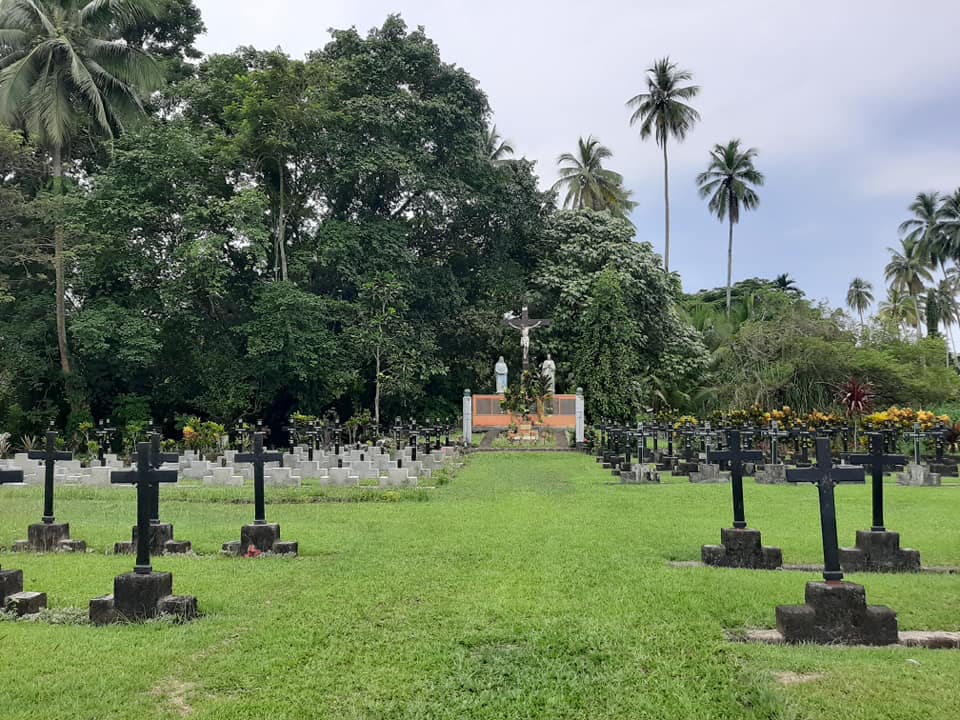
These are the Dutch sisters that were massacred during WWII. A monument for all 160 victims (2 bishops, 25 priests, 36 brothers, 56 sisters) was erected at Alexishafen in Papua New Guinea in 2013.
| KLOOSTERNAAM | DOOPNAAM | FAMILIENAAM | GEBOREN | NAT. | PROF. | MISSIE | †JAAR | †DAG/M | BIJZ. | BEGRAVEN | |
| Machuta | Margaretha | Stijger | 19-03-1895 | Ned. | 1921 | P.N,G. | 1943 | 18-3 | P.N.G. | ||
| Adulpha | Adriana | Ypelaar | 06-03-1891 | Ned. | 1920 | P.N.G. | 1944 | 13-2 | P.N.G. | ||
| Alquirina | Elisabeth | Velzen van | 11-12-1908 | Ned. | 1931 | P.N.G. | 1944 | 6-2 | P.N.G. | ||
| Cunera | Maria Elisabeth | Frericks | 10-09-1899 | Ned. | 1921 | P.N.G. | 1944 | 6-2 | P.N.G. | ||
| Domitiana | Geertrudis | Hendriks | 18-08-1900 | Ned. | 1931 | P N.G. | 1944 | 9-2 | P.N.G. | ||
| Godeberta | Adriana | Beurden van | 06-09-1893 | Ned. | 1923 | P.N.G. | 1944 | 7-4 | P.N.G. |
On 22 April 1944, US forces aided by a small Dutch detachment invaded Hollandia. The Allies liberated 125 missionaries who placed under the care of Major David Schermer of the Netherlands Indies Civil Administration (NICA). The Netherlands Indies Forces Intelligence Service interviewed the missionaries and hey provided valuable intelligence on the attitudes of the natives in their former parishes. The nuns and other missionaries were transported to the Dutch hospital ship Maetsuycker for medical treatment. Of the 92 Holy Spirit Missionary Sisters stationed in New Guinea, 54 died during the war.
Eighteen surviving sisters joined five other sisters who had arrived earlier after trekking for months across the mountains and valleys of Papua New Guinea. They were all evacuated to Brisbane. I would have loved to give tribute to these very special sisters, but I unfortunately was unable to trace their names. Many of the surviving sisters were German and this complicated their lives, but this didn’t stop some of the convent communities in Brisbane offering a temporary home to them.
The then Catholic Archbishop of Brisbane, James Duhig, invited them to stay in Brisbane, and open a Novitiate house. He offered them the 22 acre Colonel Raff house and farm property in Aspley, then the most northern suburb of Brisbane. (Original title deeds go back to Thomas Carseldine, 1866). On March 27th 1945, six of the surviving sisters from PNG moved there to set up the first Holy Spirit Convent in Australia. In 1946, the first Australian woman came to join them, followed by dozens in the following years. A number of these became committed members, offering their talents and skills to the many ministries that developed.
In 1947, the Archdiocese of Brisbane transferred ‘Garth House’ to the Sisters.
Garth House- Wickham Terrace Brisbane
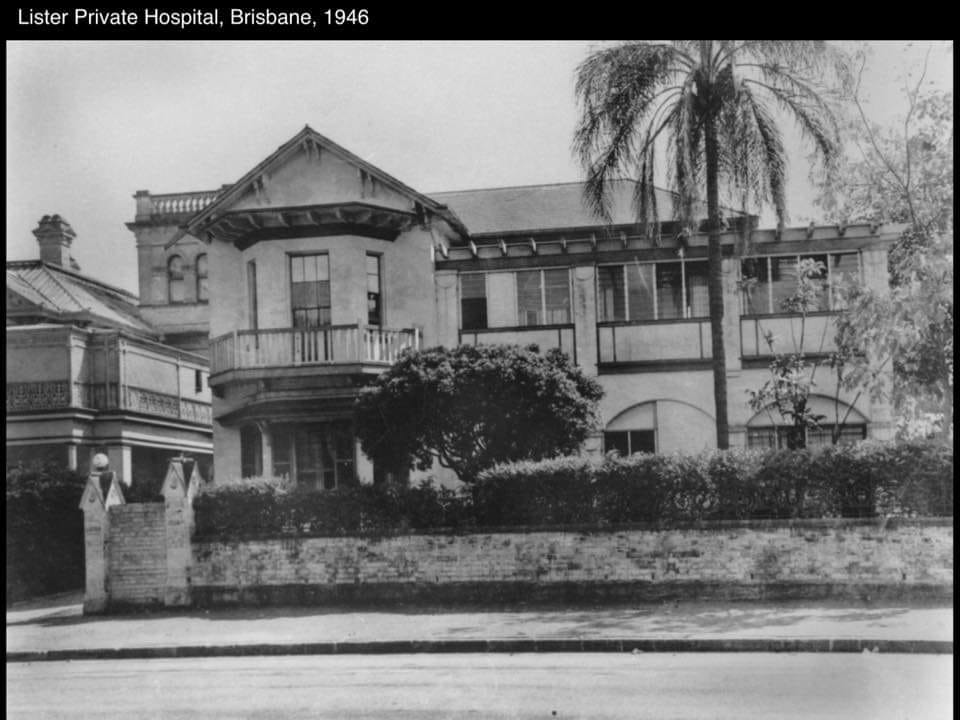
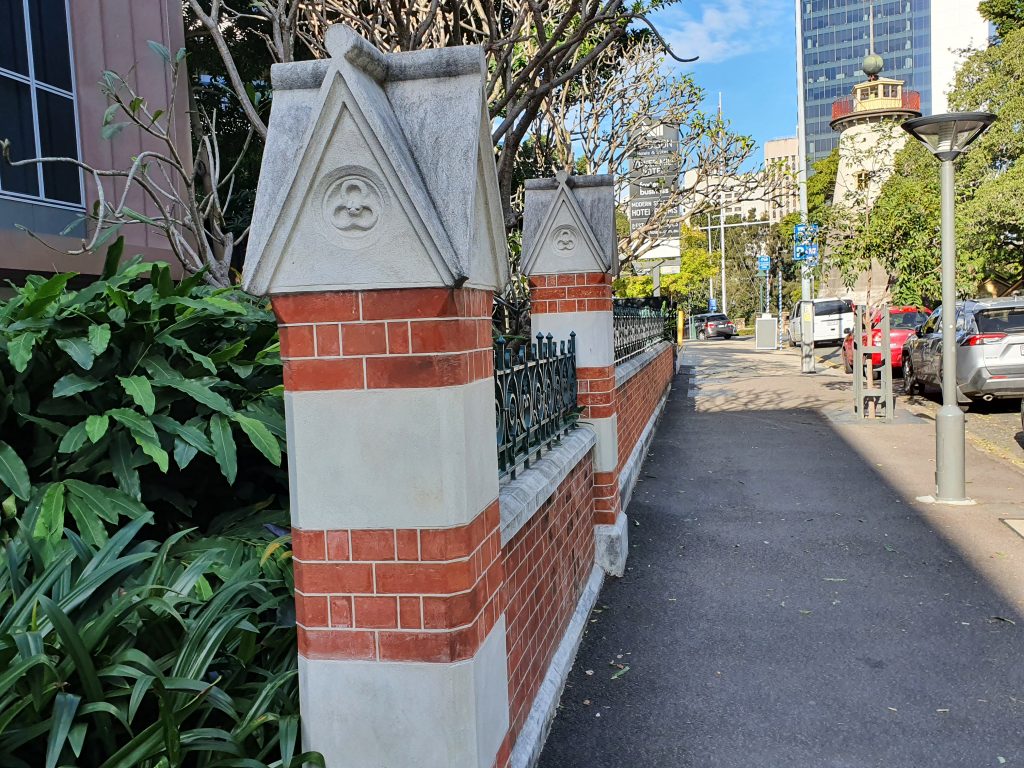
| In 1864, William John Munce purchased 2 roods and 39 perches of land, described as Portion 169 that fronted Wickham Terrace, in Spring Hill. He had constructed on the site, a stone residence that he named ‘Garth House’. The Roman Catholic Archdiocese of Brisbane purchased ‘Garth House’ on 8 June 1920. It was used as an investment property and was converted into flats.The Roman Catholic Church already owned the two neighbouring properties at 269 and 279 Wickham Terrace. The nineteenth century residence ‘Abbotsleigh’ had been purchased by the Church and later opened as a male residential quarter for University of Queensland students, named St. Leo’s College, on 30 September 1917, while another residence ‘Erneton’ (built 1887) had been purchased by the Church in 1919 and used as an extension of St Leo’s College before it was converted into the Lister Private Hospital c 1941. |
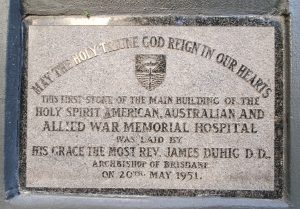
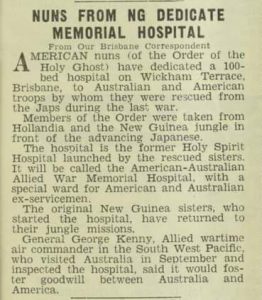
Thus, with two neighbouring nineteenth century residences already altered for multiple occupancies, the sisters converted ‘Garth House” into their Holy Spirit Hospital.
In 1950, the by now 100 bed hospital was dedicated by the sisters to the troops who had rescued the sisters in Hollandia. They called it the Holy Spirit American, Australian and Allied War Memorial Hospital. A year later Archbishop Duhig laid the foundation-stone of a new Holy Spirit War Memorial Hospital. At that time one of the nuns who was a prisoner of war of the Japanese was still nursing at the hospital.
Commencing in 1965, the three nineteenth century houses were gradually demolished to make way for a modern Holy Spirit Hospital (H.S.H). This fence remnant in the photo above is all that was retained after the three nineteenth century grand residences were demolished.
H.S.H became the Sisters’ chief “money-earner’, enabling them to support their many other free ministries here and overseas (particularly Health Care in India).
Towards the end of the nineties, at 190 bed capacity, there was a need to further expand. About that time, the Q’ueensland Government was offering the possibility of co-location on Public Hospital sites to interested Catholic Health Providers. (A plan to share and enhance each other’s capabilities and services). In July 2001, the Holy Spirit Northside Private Hospital opened on Prince Charles Hospital Campus, Chermside – a Joint Venture Agreement with the Sisters of Charity and St. Vincents Health Australia.
In 2003, the Sisters sold the Hospital at Wickham Terrace to Queensland Private Hospitals Ltd. It is currently known as Brisbane Private Hospital and in 2007 was acquired by Healthscope.
The Sisters, freer of institutional commitments, were now able to concentrate on their core “missionary work” among the neediest in our society. As the gap between rich and poor widens, there is an increasing need for a more just, compassionate society. Over the years since 1945, they have become involved in an amazing variety of ministries in eastern and central Australia. With their very multicultural, multi-talented, feminine presence, the Holy Spirit Sisters are among those committing their lives to this goal.
I am very grateful for the assistance of Sister Christa Murphy who at the age of 88+ years reviewed and edited this text, all done by email. A truly amazing person.
She also offered the following text with which I gladly end this article, as I fully agree with the Sisters on this.
Our Mission: “To witness to the presence of the Spirit of Life and Love as we journey with people, affirming Life, promoting Justice, offering Hope”.
Sources:
Missiezusters Dienaressen van de Heilige Geest
Holy Spirit Missionary Sisters
Queensland World War II Historic Places
